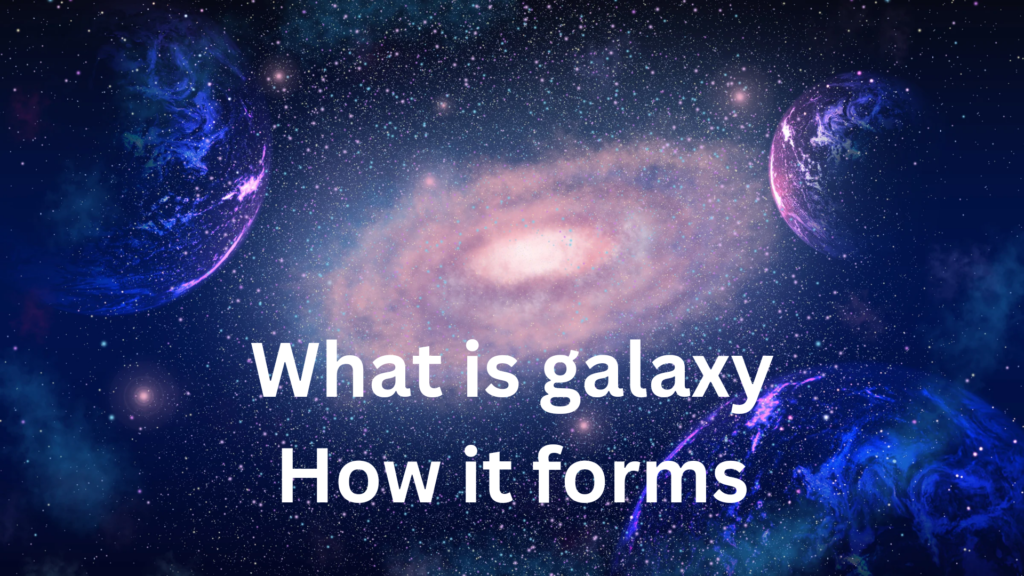

Massive systems called galaxies are made up of dust, dark matter, interstellar gas, stars, and stellar remnants that are all held together by gravity. With millions to trillions of stars living in each galaxy, they are the fundamental units of the cosmos. To have a deeper understanding of galaxies, let us explore their numerous facets.
What is Galaxy
A galaxy is a large system made up of gas, dust, stars, stellar remnants, and dark matter that is gravitationally bound. Greek word “galaxias,” which means “milky,” is where the word “galaxy” originates, and it alludes to our own Milky Way galaxy. Galaxies come in a variety of sizes and shapes and are essential to the universe’s structure.
Formation of Galaxies
Galaxies form by a complicated process that started at 13.8 billion years ago, not too long after the Big Bang. The principal phases consist of:
1. Dark Matter Halos :- Dark matter halos are dense pockets of dark matter that collapse gravitationally and are where galaxies form.
2. Gas Cooling and Fragmentation :- Stars and star clusters form as a result of the cooling and fragmentation of gas within these halos.
3. Mergers and Interactions :- Through mergers and interactions with other galaxies, galaxies expand and change. These occurrences have the power to alter the structure of galaxies and start fresh waves of star formation.
4. Star Formation and Evolution :- Galaxies continue to create new stars over billions of years, while the stars that already exist mature and change.
Life Cycle of Galaxies
Galaxies experience a dynamic life cycle that is impacted by both external and internal factors. Below is a summary of the major phases:
1. Birth
• Protogalactic Clouds: – Protogalactic clouds made of gaseous hydrogen and helium are the precursors of galaxies. Gravity causes these clouds to collapse, creating dark matter halos.
• Initial Star Formation: – The earliest stars and star clusters are created when the gas breaks up into smaller clouds as it cools.
2. Growth and Evolution
• Accretion and Merger: – By absorbing gas and combining it with other galaxies, galaxies expand. Star formation bursts may result from these interactions.
• Formation of Structure: – Galaxies grow unique features over time, including bulges, bars, and spiral arms. The galaxy’s evolution is shaped by the interplay between gravitational forces, supernova explosions, and star formation.
3. Mature Phase
• Stellar Population Changes: – When a galaxy reaches a mature stage, it stops forming new stars at the same rate. As the population of stars ages, older stars start to predominate.
• Quiescent Phase: – During a quiescent phase, when star production is minimal or nonexistent, many elliptical galaxies are dominated by ancient, red stars.
4. Interacting and Merging
• Galaxy Collisions: – Galaxies frequently collide and merge, which causes significant shifts in their star formation rates and structure. Larger new galaxies may form as a result of these encounters.
• Starburst and AGN Phase: – Active galactic nuclei (AGN) can result from mergers that excite central supermassive black holes and cause violent starbursts.
5. Aging and Death
• Exhaustion of Gas: – Galaxies may eventually run out of gas, which would stop the creation of new stars. The older, dying stars start to dominate them.
• Transformation: – Certain galaxies, particularly dwarfs, may be swallowed by larger galaxies and tidally stripped, losing their individuality.
6. Reclycling and Renewal
• Feedback Mechanism: – Renewing star formation may eventually result from processes such as supernova explosions and AGN activity injecting energy into the interstellar medium and forcing gas out of the galaxy or redistributing it.
Types of Galaxies
Based on their appearance and structural characteristics, galaxies are categorized into multiple categories. The Hubble Sequence, developed by Edwin Hubble, is the most widely used classification system. The primary categories of galaxies are:
1. Spiral Galaxies
Characteristics: – A flat, revolving disk with spiral arms and a central bulge characterizes spiral galaxies. Both young and old stars might be found among them.
Examples: – Milkyway, Andromeda galaxy.
Subtypes: – based on the existence of a central bar structure, divided into barred spirals (e.g., SB) and regular spirals (e.g., S, SA).
2. Elliptical Galaxies
Characteristic: – Elliptical galaxies are smooth, featureless objects having an ellipsoidal form. They are typically devoid of gas and dust and mostly comprise older stars.
Examples: – Messier 87, NGC 5128 (Centaurus A).
Subtypes: – categorized as almost spherical (E0) to substantially elongated (E7).
3. Lenticular Galaxies
Characteristics: – A form of galaxy that lies in between spiral and elliptical galaxies is called lenticular galaxies (S0). They lack pronounced spiral arms but do feature a disk and a center bulge.
Examples: – NGC 5866, NGC 1023.
4. Irregular Galaxies
Characteristics: – Galaxies that are irregular in shape and structure are not well-defined. They frequently have regions of active star formation along with significant amounts of gas and dust.
Examples: – Large Magellanic Clouds, Small Magellanic Clouds.
Characteristics of Galaxies
Galaxies have a diverse array of properties that are shaped by their type, composition, and evolutionary background.
1. Size and Mass: – From dwarf galaxies with a few billion stars to gigantic galaxies with trillions of stars, the sizes of galaxies differ dramatically. They can weigh between 10^7 and 10^12 solar masses.
2. Stellar Population: – Star populations in galaxies are diverse and include both old, cool stars and new, hot stars. The galaxy’s hue and luminosity are influenced by the mixture of these populations.
3. Interstellar Medium: – The interstellar medium, made up of gas and dust, fills the voids between stars in a galaxy. The star formation process depends on this medium.
4. Dark Matter: – Dark matter, an opaque substance that does not emit light but has gravitational pull, is the dominant component of galaxies. Approximately 85% of the universe’s entire mass is composed of dark matter.
5. Active Galactic Nuclei: – Supermassive black holes, which can become active and release massive quantities of energy to produce active galactic nuclei (AGN), are found at the centers of some galaxies.
Some Popular Galaxies
1. Milky Way Galaxy
• Description: – The barred spiral galaxy that is our home galaxy has a diameter of roughly 100,000 light-years. Our Sun is one among the more than 200 billion stars in it.
• Notable Features: – Central bulge, Spiral Arms, Galactic Halo.
2. Andromeda Galaxy (M31)
• Description: – Spiral galaxy nearest to the Milky Way, roughly 2.537 million light-years distant. It will likely merge with the Milky Way in roughly 4.5 billion years as it approaches a collision course with it.
• Notable Features: – pronounced spiral arms with a Milky Way-like pattern.
3. Messier 87 (M87)
• Description: – A massive elliptical galaxy situated roughly 53.5 million light-years distant in the Virgo Cluster. Recognized for its enormous black hole at the center, which the Event Horizon Telescope was able to image.
• Notable Features: – Large globular cluster system, jet of relativistic particles.
4. Large Magellanic Cloud (LMC)
• Description: – a Milky Way satellite galaxy that is roughly 163,000 light-years distant. Star-forming areas are active in this irregular galaxy.
• Notable Features: – Regions of strong star production are called Tarantula Nebulas.
5. Simbrero Galaxy (M104)
• Description: – a lenticular galaxy in the Virgo constellation that is situated at 29.3 million light-years distant. It is distinguished by a noticeable dust lane and a brilliant nucleus.
• Notable Features: – Bulge and disk structure, edge-on appearance
Conclusion
Galaxies are a key component of the universe and are incredibly diverse and interesting phenomena. Knowing about their kinds, origins, traits, life cycles, and prominent instances enables us to recognize the intricacy and magnificence of the cosmos. Every galaxy has a different tale to tell about the universe’s evolution, whether it is the Milky Way’s spiral arms, Messier 87’s elliptical grandeur, or the Large Magellanic Cloud’s erratic appeal.
